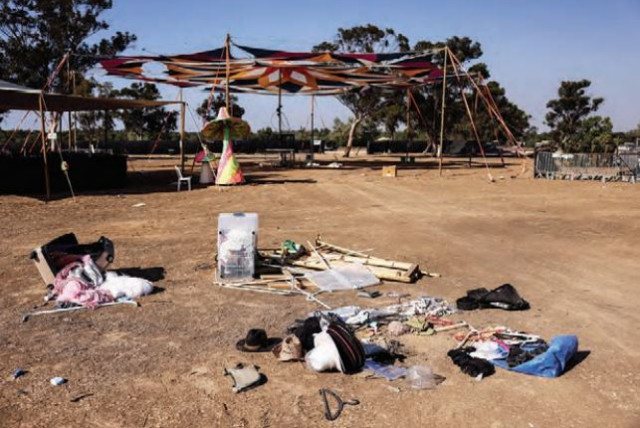Extensive efforts to collect the documentary evidence from the October 7 massacre

The goal is to create a large, authoritative database encompassing the entirety of evidence, documentation, media coverage, and outreach activities, for the benefit of Jewish communal memory.
Shortly after the October 7 Hamas massacre on Israel’s southern border, it became clear quite quickly that it was the first event of its kind that was almost wholly documented digitally, and that if it was not properly and swiftly organized and preserved for historical research, it would be destined to disappear.
Recognizing the transient and changeable nature of this digital media, the National Library of Israel launched a project of collaborative leadership working together in partnership with other institutions and dozens of collection efforts to serve as a central repository for all existing documentation of these events: texts, photos, audio, and video.
We are in the digital age
“The digital era poses new challenges (for archiving material). One of the side aspects of what we are experiencing is that the events of October 7 were so horrifically physical, but the documentation around it is almost exclusively digital—which shows us we are in [the] digital age—and work in digital needs to be done in real time,” said Dr. Raquel Ukeles, head of collections at the National Library of Israel. “This is very different type of work (than other archival work).”
The goal is to create a large, authoritative database encompassing the entirety of evidence, documentation, media coverage, and outreach activities, for the benefit of Jewish communal memory and historical research, and to make this evidence available and accessible for the long-term, she said.
“It is already clear that even after the war’s end, the need to understand, study, and research the events of October 7th and the current war, and their social, cultural, military, and political consequences will remain relevant and important for decades to come,” she said.
Partners in what is planned to be a five-year project are wide and varied and include: the Israel Oral History Association (ILOHA), the Oral History Division at the Avraham Harman Institute of Contemporary Jewry at the Hebrew University of Jerusalem; the Association of Israeli Archivists; the Zvi Yavetz School of Historical Studies at Tel Aviv University; the USC Shoah Foundation; the Association of Jewish Libraries (AJL); the Berman Archive at Stanford University; the Israeli Civil Administration; the Leadership Forum for War Documentation Initiatives; Edut 710 and Moked Arava.
Many of those who began collecting material are volunteers, she noted.
“We are in touch with dozens of collections and are offering them professional guidance and a home for the material they are collecting. They are volunteers and recognize the importance of the material, but do not have a home for long-repository,” she said.
The Israeli Civil Administration has already transferred about 200,000 photos and videos. In addition, to date, the project has determined there are tens of thousands of texts, audio and video recordings of fallen victims and fighters, interviews with survivors, families of hostages, plus hundreds of thousands of video recordings created by the IDF and the security forces, advocacy organizations, private individuals – as well as by the terrorists themselves.
They are aiming to collect as much as possible in many types of material, said Ukeles, and are not limiting their efforts to one genre or format as are other collection effort. “We are collecting across all these formats and categories with the goal to build a national repository that will allow us to first preserve all of this material for the benefit of Jewish communal memory and historical research, and to make this evidence available and accessible for the long-term, also to open access as much as legally and morally possible.”
The Bosnian war in the early 1990s is considered to be first war conducted with cell phones in use where people were documenting in real time what was happening, she said. The same is being done now in the war in Ukraine, she noted.
“This changes the nature of war but still it does not shut down denial. Even though we are documenting the events of October 7 basically in real time, we saw how quickly there were those who were celebrating the Hamas massacre and those who denied the Hamas massacre at the same time,” she said.
It raised the “poignant question” of what is means to create a historical record when accusations of deep fake are circulating and how material can be authenticated, and if the authentication process is the role of the library, said Ukeles.
“If the goal is to establish a corpus of material for the historical record, and we are in an age where the historical record is contested in real time, what then is our responsibility?” she said. “The logic is to build a massive corpus of material with eyewitness accounts with a tremendous amount of documentary evidence. But let’s not kid ourselves that that is sufficient, and I don’t if that is our job as library.”
From the Syrian Archive project digitally preserving memories of the 2011 Syrian uprising to the digital preservation of Ukrainian cultural heritage there are digital projects all over the world that attempt to document digital historical memory of world events.
“This is a function of the age we are in,” said Ukeles. “I don’t think Jews are unique in collecting (documentation). I think Jews have a very well-honed instinct for collecting and documenting our history and documenting terrible events that happened to us. We have deep roots in documenting our history and a very strong historical consciousness.”
Jerusalem Post Store
`; document.getElementById("linkPremium").innerHTML = cont; var divWithLink = document.getElementById("premium-link"); if (divWithLink !== null && divWithLink !== 'undefined') { divWithLink.style.border = "solid 1px #cb0f3e"; divWithLink.style.textAlign = "center"; divWithLink.style.marginBottom = "15px"; divWithLink.style.marginTop = "15px"; divWithLink.style.width = "100%"; divWithLink.style.backgroundColor = "#122952"; divWithLink.style.color = "#ffffff"; divWithLink.style.lineHeight = "1.5"; } } (function (v, i) { });

